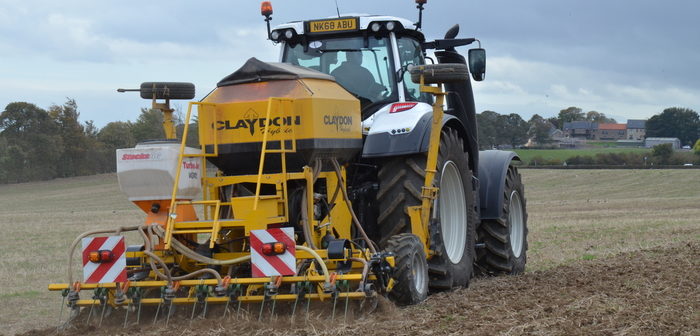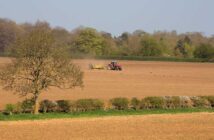Using strip seeding solely to save money is the wrong approach, believes County Durham farmer David Hankey. Instead, he says that caring for the soil must come first and everything else will follow, John Swire reports
“The more you work with nature the better the results,” says Mr Hankey, who farms 121ha at Dunkirk Farm, Chester-le-Street. Currently the farm is on a five-year rotation, but the aim is to widen this to seven years, comprising winter beans, winter wheat, a cover crop, spring barley, winter wheat, winter barley, oilseed rape and winter wheat. He also contract-farms an additional 100 acres and drills 68ha each year for other farmers in the area.
Mr Hankey says: “In the north of England, the amount of time between harvest and drilling autumn-sown crops is generally much shorter than in the south. We are often still combining at the end of August and drilling soon afterwards so, with a conventional system, that does not leave much time to do things. Because the output of the Claydon direct strip seeding system that I have used for the last four years is so high compared with ploughing and combination drilling that I used previously there is no rush.”
Cattle featured at Dunkirk Farm until 2001, when foot-and-mouth disease struck, and combined with a very good rotation resulted in wheat yields of up to 11.1t/ha. The mostly sandy clay loam cannot be classed as heavy, but years of ploughing and conventional cultivations, combined with continuous cereal crops, had left it in poor condition and with no real structure. In 2010 the land started to slump, the amount of compaction from field traffic increased and ploughing down straw year after year had led to the soil becoming more anaerobic. When yields started to slip further back towards 8.6t/ha Mr Hankey looked at what could be done to reverse the process.
Extreme weather over the 2010-2011 winter and again in 2012-2013 took a further toll on the soil and the land became increasingly difficult to work. Many crops in the area were muddled in that autumn and consequently the following harvest wasn’t great. That was the last year that crops were produced after land had been ploughed and combination drilled.
Having decided to move away from this method of establishment Mr Hankey had contractors drill the following season’s crops using three different machines, a Sumo DTS, Mzuri ProTill and Vaderstad Spirit, but each had their drawbacks, such as a lack of under-frame clearance which led to blocking. Wanting a versatile 3m mounted drill that would reliably establish any crop in any conditions, he looked at all the options and after much research visited three farms which used the Claydon System.
Mr Hankey visited the company’s factory in Suffolk and saw the benefits of using it correctly during a tour of the Claydon family’s arable farm, where Jeff Claydon has used the system he invented since 2002. Mr Hankey placed an order for a new 3m Claydon Hybrid in spring 2015 and the company’s territory manager, Taig Norman, visited the farm to set the new drill up, where it was used to establish the first cover crops in June that year. The farm was one of the first to try Claydon’s leading discs and the crop of Skyfall winter wheat which followed yielded 10.1t/ha.
In 2015 and 2016 the standard combination of leading tines and discs was used for establishing cereals, but the soil has improved so much that now most of the time that David uses just the front cutting discs. Water infiltration tests have confirmed that the soil’s ability to drain and water-holding capacity are now far greater and continue to improve.
After just two years of using the Claydon System yields were back to 11.6t/ha, while establishment costs were a fraction of what they had been before. With the previous system, ploughing with a five-furrow reversible followed immediately by a power harrow/drill combination, the amount of diesel used was 45 litres per hectare, five times as much as the 9 litres/ha required with the Claydon System.
“We have soils tested regularly and compared with the old system, where all straw was taken off the land and fertiliser came out of a bag, we have not had to apply any phosphorus or potassium for three years,” Mr Hankey states. “Some of the cereal straw and all of the bean and oilseed rape residues are chopped to help build up soil organic matter.
“The Claydon Hybrid is very versatile and has created a much improved, more open soil structure which is much better able to support the weight of following machinery. The land walks so much better now and has become almost self-healing: rather like a sponge, any wheelings that are created disappear very quickly. The worm population has also increased dramatically and there are so many that they are incredibly effective at taking the chopped crop residues down into the soil, so within about six weeks it has all disappeared. Every year the soil gets better and better. I cannot expect to continue seeing the same big gains that have been the case over the last four years, but that process continues.
“In many cases the soil structure is now so good because of the honeycomb of roots which remain that often I just use the disc coulters when drilling cereals 30mm to 35mm deep, and the leading tine only when drilling oilseed rape or beans because of the extra depth required. The Claydon drill acts like a grading machine and over the last four years it has levelled the fields so well that it makes following operations such as spraying and harvesting much easier, quicker and kinder on machinery. The soil has also become much easier to work and the front cutting discs covered 607ha before they needed to be replaced, equivalent to a cost of just 66pp/ha.”
The key to using the Claydon System successfully, David emphasises, is to commit to it and not be tempted to plough, for any reason. If ploughs were banned, he says, soils, crops and biodiversity would be the better for it.




